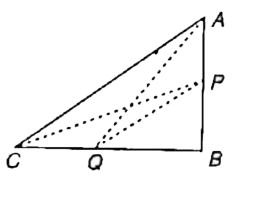In an isosceles right angle triangle ABC (at B) perpendicular are drawn from a point D inside the triangle on side AB and AC meet at p and Q respectively . AP = a unit ,AQ = b unit ∠PAD = 15∘, sin 75° = ?
(a) 2b/√3a
(b) a/2b
(c) √3a/2b
(d) 2a/√3b
The correct Answer is:√3a2b
To solve the problem, we will follow these steps:
Step 1: Understand the Triangle Configuration
We have an isosceles right triangle ABC with a right angle at B. Points P and Q are where perpendiculars from point D (inside the triangle) meet sides AB and AC, respectively. We know AP = a units, AQ = b units, and angle PAD = 15°.
Step 2: Determine Angle Relationships
Since triangle ABC is a right triangle at B, the angles at A and C are both 45°. We can find angle ADQ using the angle sum property:
- Angle PAD = 15°
- Angle ADB = 90° (since it’s a right triangle)
- Therefore, angle ADQ = 90° - 15° = 75°.
Step 3: Use the Sine Definition
To find sin 75°, we can use the definition of sine in triangle ADQ:
- sin(75°) = Opposite side (AQ) / Hypotenuse (AD).
Step 4: Express AD in Terms of a and b
In triangle ADQ, we can apply the sine function:
- sin(60°) = Opposite (AQ) / Hypotenuse (AD)
- We know AQ = b, and sin(60°) = √3/2.
Thus, we can set up the equation:
sin(60°)=bAD
√32=bAD
From this, we can solve for AD:
AD=2b√3
Step 5: Substitute AD into the sin(75°) Equation
Now we can substitute AD back into the equation for sin(75°):
sin(75°)=APAD=a2b√3
This simplifies to:
sin(75°)=a⋅√32b
Final Answer
Thus, the value of sin 75° in terms of a and b is:
sin(75°)=√3a2b
---
We have an isosceles right triangle ABC with a right angle at B. Points P and Q are where perpendiculars from point D (inside the triangle) meet sides AB and AC, respectively. We know AP = a units, AQ = b units, and angle PAD = 15°.
Since triangle ABC is a right triangle at B, the angles at A and C are both 45°. We can find angle ADQ using the angle sum property:
- Angle PAD = 15°
- Angle ADB = 90° (since it’s a right triangle)
- Therefore, angle ADQ = 90° - 15° = 75°.
To find sin 75°, we can use the definition of sine in triangle ADQ:
- sin(75°) = Opposite side (AQ) / Hypotenuse (AD).
In triangle ADQ, we can apply the sine function:
- sin(60°) = Opposite (AQ) / Hypotenuse (AD)
- We know AQ = b, and sin(60°) = √3/2.
Thus, we can set up the equation:
sin(60°)=bAD
√32=bAD
From this, we can solve for AD:
AD=2b√3
Now we can substitute AD back into the equation for sin(75°):
sin(75°)=APAD=a2b√3
This simplifies to:
sin(75°)=a⋅√32b
Thus, the value of sin 75° in terms of a and b is:
sin(75°)=√3a2b
Topper's Solved these Questions
Similar Questions
Knowledge Check
Dileep started a business with a capital of Rs. 8000. After six months, Narender joined him with some investment. If at the end of the year each of them gets equal amount as profit, how much did Narender invest in the business?
AA) 24000BB) 16000CC) 12000DD) 32000An isosceles triangle ABC is right angled at B.D is a point inside the triangle ABC. P and Q are the feet of the perpendiculars drawn from D on the sides AB and AC respectively of ΔABC. If AP = a cm, AQ = b cm and ∠BAD=15∘,sin75∘=
A2b√3aBa2bC√(3)(a)2bD2a√3bAn isosceles ΔABC is right angled at B. D lies inside ΔABC. P and Q are resectively the base of perpendiculars drawnon side AB and AC of ΔABC from point D. If AP = a cm, AQ = b cm and ∠BAD=15∘, then what will be sin75∘?
A2b√3aBa2bC√3a2bD2a√3b
In an isosceles triangle ABC with AB=AC, a circle passing through B and C intersects the sides ABandAC atDandE respectively. Prove that DECB.
View SolutionABC is right triangle right angled at B.If BD is the length of the perpendicular drawn from B to AC then
View SolutionIn a right angled triangle ABC,D is the foot of the perpendicular from B on the hypotenuse AC. If AB=3cm and BC=4cm, what is the area of △ABD
View SolutionIn an isosceles triangle ABC, AB=AC and ∠A=3∠B. Find ∠C.
View SolutionIn right angled ΔABC,∠B=90∘, if P and Q are points on the sides AB and BC respectively, then :

View Solution
